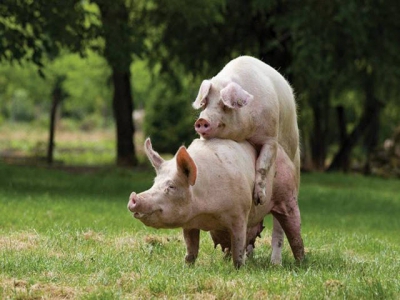Nutrition guidelines for feeding breeding boars

Breeding males receive the least attention when it comes to research and information transfer, but they deserve more as they account for 50 percent of the genes in market pigs.
Breeding boars are mature animals, not much different than gestating sows, when it comes to feed digestion. | Jevtic
To properly balance complete feeds and prepare commercial products for breeding boars, it is important to begin with setting appropriate goals, in which case we can focus on the following three:
- Sound development of muscles and bone structure
- High quality and quantity of sperm production
- Longevity and well-being
These goals will ensure boars remain active for a long time, at high health, while being fertile and highly profitable. It must be acknowledged that certain commercial nutrition programs and associated products (mainly nutritional supplements) might lead to different levels of achievement of the above goals. Sometimes short-term economy is a false guide that leads to long-term loss of profitability. Thus, the more we deviate from the guidelines presented below the more we deviate from these goals, reducing the useful life, performance and financial impact of our boars.
For formulation purposes, the NRC (2012) guidelines are considered adequate, but they can be adjusted to reflect actual genetics. It is always a good idea to consider working with your genetics supplier when it comes to designing your own boar nutrition program. Guidelines presented in Table 1 are sufficient for most cases, but they are just an example that can be consulted when visiting with your nutritionist.
When it comes to ingredients, it must be kept in mind that breeding boars are mature animals, not much different than gestating sows, when it comes to feed digestion. Thus, ingredient upper limits used for gestating sows are more than adequate for boar formulas. Indeed, in some cases, where we exclude or limit certain offensive ingredients from gestating diets due to their effect on embryonic health, such limitations might not be relevant for breeding boars. In general, adult boars can consume a rather large array of ingredients, but too much bulk might limit their performance.
Daily feed intake should be based on dietary energy content and estimated energy requirements. The latter are mainly for maintenance, whereas workload should be adjusted differently for boars in AI stations versus those used for natural service. General guidelines are presented in Table 2, but, again, it is best to follow genetics-specific guidelines.
Additives and special nutrients that may be added in complete feeds either as straight ingredients or part of a premix product are presented below, in order of significance, according to my personal experiences, but others might be equally important.
- Organic selenium (for enhanced sperm virility and quantity). Recommended to supply 50 percent of total needs (up to 0.5 ppm). Not all organic selenium products are the same!
- Vitamin E (for enhanced sperm quality). Recommended dietary specification up to 250 IU/kg. Alternatively, natural antioxidants might be used, but this is not a fully defined field of science, yet.
- Zinc (for enhanced sperm quality). Recommended dietary specification up to 200 mg/kg. This also helps in maintaining hoof health, which is very important for large-frame and heavy boars, especially those used for natural service.
- Biotin (for enhanced feet health). Recommended dietary specification up to 0.5 mg/kg. It is a universal vitamin added in most diets, but increased dosages are warranted when hoof health is less than acceptable (again, most important for heavier animals).
- Vitamin C (to ameliorate heat stress). Recommended dietary specification up to 500 mg/kg. It should be used along with other measures to reduce heat stress.
- Betaine (to ameliorate heat stress). Recommended dosage varies from 1 to 2 or more kg per metric ton of feed. It is a powerful cellular hydrant, and access to abundant water is thus important.
- Chromium tripicolinate (for enhanced performance based on limited data). Recommended dietary specification up to 200 ppb (parts per billion).

It is always a good idea to consider working with your genetics supplier when it comes to designing your own boar nutrition program.

Daily feed intake should be based on dietary energy content and estimated energy requirements.
Có thể bạn quan tâm
 Pig survivability project to reshape pork industry
Pig survivability project to reshape pork industry Increasing wean-to-finish survival of pigs 1% would add approximately 1.2 million pigs each year to U.S. industry.
 4 feed guidelines for breeding boars
4 feed guidelines for breeding boars Breeding boars account for 50 percent of the genes in market pigs, but they don’t receive a lot of attention when it comes to research
 4 keys to consider with organic acids in pig production
4 keys to consider with organic acids in pig production Different organic acid programs will need to be applied, depending on the goals